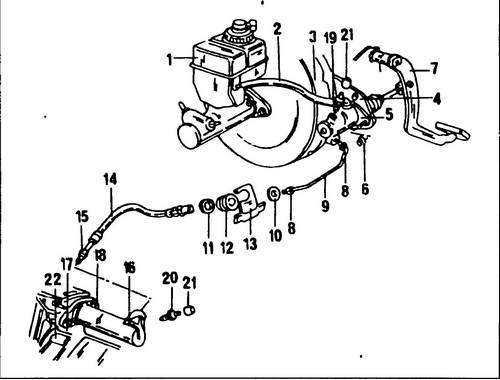Replacing the master and slave cylinders of the T4 clutch
The main components of the hydraulic clutch release are the master and slave cylinders of the clutch Transporter T4 . The master cylinder is bolted to the pedal bracket and actuated by the clutch pedal pusher. The slave cylinder is bolted to the top of the clutch housing. The fastening of the main and working cylinders is shown in fig. 325. During removal and installation of cylinders it is necessary to adhere to the following recommendations.
Rice.
325 Clutch hydraulic device 1 - expansion tank (brake fluid), 2 - brake hose, 3 - vacuum brake booster, 4 - bracket, 5 - master cylinder, 6 - nut, 7 Nm, 8, 15 - union nuts, 15 Nm , 9 - hydraulic pipe, 10, 11 - washer, 12 - sleeve, 13 - bracket, 14 - hydraulic hose, 16 - slave cylinder, 17, 18 - bolt, 25 Nm, 19 - clutch master cylinder bleeder, 20 - union pumping the working cylinder, 21 - anther, 22 - gearbox
♦ Before removing the T4 clutch master cylinder, remove the windshield washer reservoir.
♦ Do not disconnect the transmission linkages, otherwise they will have to be adjusted.
Disassembly of the main and / or working cylinders to replace the cuffs is not provided by the manufacturer. In the event of malfunctions, these units change as an assembly.
Bleeding the hydraulic clutch release
The hydraulic clutch actuator must be bled every time the hydraulic pipes/hoses are disconnected, or if air enters the system for any other reason.
The hydraulic clutch is pumped in the same way as the brake system.
The information given in Chapter 9 regarding bleeding the brake system also applies to the hydraulic clutch. Both hydraulic drives (clutch and brake system) have a common compensation tank to which the main cylinder is connected by a hose (2, see Fig. 325). The bleed hose on the master cylinder fitting should be put on in the same way as on the bleed fitting on the T4 clutch slave cylinder.
The clutch pedal should provide a noticeable amount of resistance when pressed.
